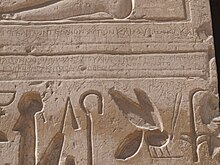From Wikipedia, the free encyclopedia
Ancient graffiti engraved on the walls of the Temple of Seti I at Abydos, Egypt
 Phoenician graffiti (right hand side) at the
Temple of Seti I
.
Phoenician graffiti (right hand side) at the
Temple of Seti I
.
The
Abydos graffiti
is
Phoenician and Aramaic graffiti
found on the walls of the
Temple of Seti I
at
Abydos, Egypt
. The inscriptions are known as KAI 49, CIS I 99-110 and RES 1302ff.
Much of the graffiti represents prayers and votive dedications.
[1]
Prior to the discovery of the Abydos graffiti, very few Semitic inscriptions had been found in Egypt ? a few Aramaic texts, the
Abu Simbel Phoenician graffiti
(published by Ampere, Lepsius, and Graham), and an engraved sphinx found in the
Serapeum of Saqqara
. Abydos was considered to contain the tomb of
Osiris
, the god of the afterlife, hence it was considered a holy burial place and attracted pilgrimage.
[2]
Discovery
[
edit
]
The first Phoenician and Aramaic graffiti was recorded by
Theodule Deveria
during Mariette's excavations at Abydos;
13 inscriptions were published in 1868 by
Hermann Zotenberg
.
[3]
Heinrich Karl Brugsch
subsequently made notes of 16 inscriptions. The inscriptions of Deveria and Brugsch were published in the first edition of
Corpus Inscriptionum Semiticarum
.
In 1885,
Joseph Derenbourg
and his son Hartwig published an interpretation of 61 inscriptions noted by
Archibald Sayce
on a visit in 1883.
[4]
A small amount of further graffiti was published by
Margaret Murray
in 1904, together with her excavations at the
Osireion
(note that no Phoenician or Aramaic graffiti was found on the Osireion which, unlike the other temples, had been hidden underground for many centuries).
[5]
The Phoenician graffiti was found to be "roughly scratched on the walls, even more roughly than the Greek".
[5]
Concordance
[
edit
]
| Deveria
|
CIS I
|
Brugsch
|
Sayce
|
| 1
|
99
|
6, 16
|
18
|
| 2
|
100a-b
|
-
|
-
|
| 4
|
-
|
-
|
5
|
| 6
|
101
|
-
|
25
|
| 7
|
-
|
-
|
4
|
| 8
|
102a-d
|
1, 2, 10
|
36?38, 40
|
| 9
|
-
|
-
|
61
|
| 10
|
103a-c
|
-
|
21-23
|
| 11
|
104
|
-
|
-
|
| 12
|
105
|
-
|
1
|
| 13
|
-
|
-
|
41
|
| -
|
106
|
8, 13
|
2
|
| -
|
110
|
-
|
3
|
| -
|
109
|
15
|
19
|
| -
|
107
|
12
|
31
|
| -
|
108
|
14
|
-
|
Gallery of handwritten notes
[
edit
]
CIS, including Deveria and Brugsch
[
edit
]
-
Deveria 8, 9, 11
-
Deveria 1?7, 10, 12-13
-
Brugsch 1-16
-
CIS I 98, 110
Murray
[
edit
]
Sayce
[
edit
]
-
Sayce 1-15
-
Sayce 16-31
-
Sayce 32-46
-
Sayce 47-61
Notes
[
edit
]
- ^
Naveh, J. (1979).
Graffiti and Dedications
. Bulletin of the American Schools of Oriental Research, (235), 27-30. doi:10.2307/1356553
- ^
Zotenberg, H., "
Nouvelles inscriptions pheniciennes d'Egypte
." JA ser. 6, t. 11 (1868): 431?50 + 2 pls (also at
BNF
, including full plate scans): "Dans le grand nombre d'inscriptions diverses qui ont ete trouvees jusqu'a ce jour aux bords du Nil, les anciennes inscriptions semitiques sont fort rares... En dehors de quelques textes arameens, les seules inscriptions pheniciennes decouvertes en Egypte jusqu'a ce jour, sont celles d'Ipsambul, copiees successivement par Ampere, Lepsius, et Graham, et quatre lignes gravees sur un des sphinx du serapeum de Memphis... Deux temples, dont l'un construit par Seti Ier l'autre par Ramses II, lui etaient consacres. Elle renfermait, en outre, le tombeau d'Osiris... Mais Abydos avait la pretention de posseder le vrai tombeau du dieu Osiris, et cette croyance eut pour effet que beaucoup d'Egyptiens, de toutes les parties du pays, firent etablir leurs sepultures a proximite de l'endroit ou reposait le dieu. Il est naturel que cette coutume ait ajoute a la saintete du lieu et du culte d'Abydos. Aussi cette ville attira-t-elle de tres-nombreux pelerins venus de tous cotes pour y adorer Osiris.
- ^
Zotenberg, H., "
Nouvelles inscriptions pheniciennes d'Egypte
." JA ser. 6, t. 11 (1868): 431?50 + 2 pls (also at
BNF
, including full plate scans)
- ^
Derenbourg, J., & Derenbourg, H. (1885).
LES INSCRIPTIONS PHENICIENNES DU TEMPLE DE SETI A ABYDOS, PUBLIEES ET TRADUITES D'APRES UNE COPIE INEDITE DE M. SAYCE
. Revue D'Assyriologie Et D'archeologie Orientale, 1(3), 81-101: "En visitant a la fin de 1883 le temple construit par Seti Ier a Abydos, dans la Haute-Egypte, M. Sayce a pris soin d'y copier toutes les inscriptions pheniciennes, dont une partie seulement avait ete relevee par Deveria et Brugsch. Il y a beaucoup de nouveau dans les soixante et un petits textes, que M. Sayce a bien voulu nous envoyer."
- ^
a
b
The Osireion at Abydos
, 1904
Bibliography
[
edit
]
- Zotenberg, H., "
Nouvelles inscriptions pheniciennes d'Egypte
." JA ser. 6, t. 11 (1868): 431?50 + 2 pls (also at
BNF
, including full plate scans)
- Levy, M.A., "
Inschriften aus Abydos in Aegypten
." Pp. 14?35 + 1 pl. In Phonizische Studien. , Breslau: Schletter, 1870
- Derenbourg, J., & Derenbourg, H. (1885).
LES INSCRIPTIONS PHENICIENNES DU TEMPLE DE SETI A ABYDOS, PUBLIEES ET TRADUITES D'APRES UNE COPIE INEDITE DE M. SAYCE
. Revue D'Assyriologie Et D'archeologie Orientale, 1(3), 81-101
- Murray, M.A., The Osireion at Abydos. Egyptian Research Account, Ninth Year, 1903 . London: B. Quaritch, 1904
- Kornfeld, W., "Neues uber die phonikischen und aramaischen Graffiti in den Tempeln vom Abydos."
OAW
, 115 (1978a): 193?204 + 18 pls.